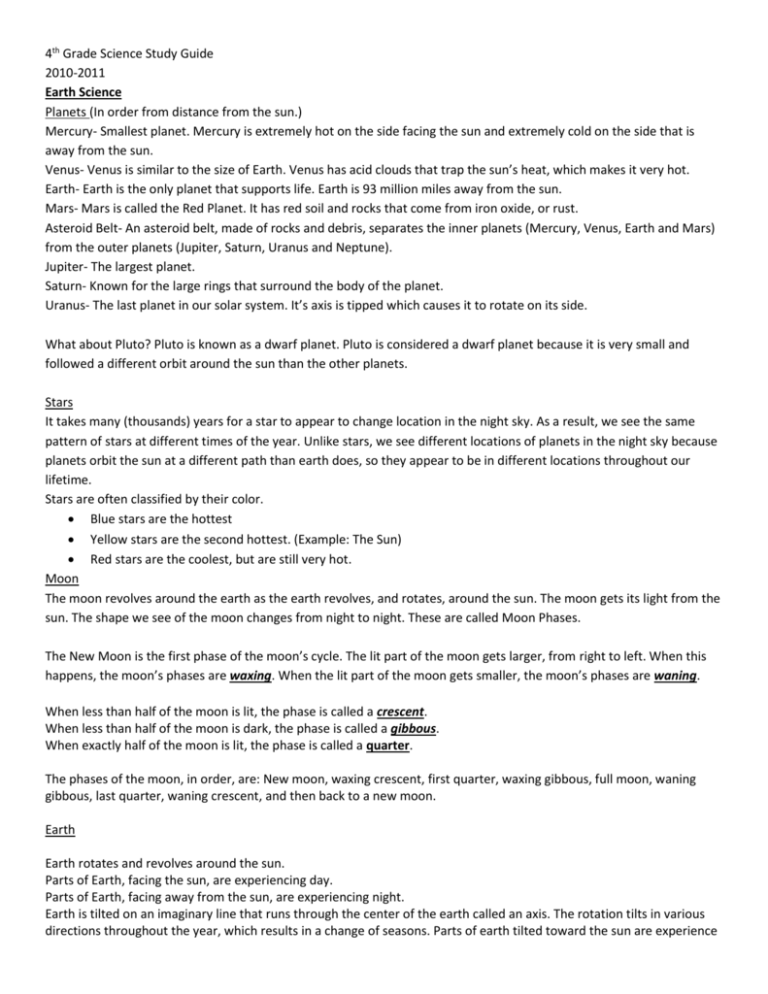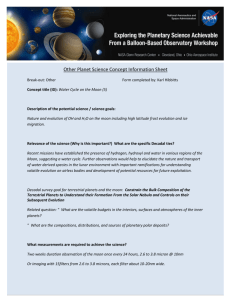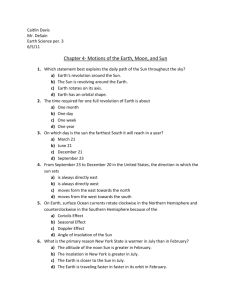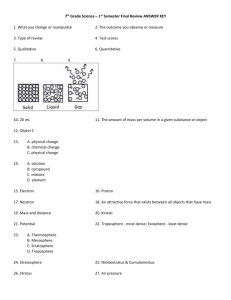4th grade CRCT science study guide
advertisement

4th Grade Science Study Guide 2010-2011 Earth Science Planets (In order from distance from the sun.) Mercury- Smallest planet. Mercury is extremely hot on the side facing the sun and extremely cold on the side that is away from the sun. Venus- Venus is similar to the size of Earth. Venus has acid clouds that trap the sun’s heat, which makes it very hot. Earth- Earth is the only planet that supports life. Earth is 93 million miles away from the sun. Mars- Mars is called the Red Planet. It has red soil and rocks that come from iron oxide, or rust. Asteroid Belt- An asteroid belt, made of rocks and debris, separates the inner planets (Mercury, Venus, Earth and Mars) from the outer planets (Jupiter, Saturn, Uranus and Neptune). Jupiter- The largest planet. Saturn- Known for the large rings that surround the body of the planet. Uranus- The last planet in our solar system. It’s axis is tipped which causes it to rotate on its side. What about Pluto? Pluto is known as a dwarf planet. Pluto is considered a dwarf planet because it is very small and followed a different orbit around the sun than the other planets. Stars It takes many (thousands) years for a star to appear to change location in the night sky. As a result, we see the same pattern of stars at different times of the year. Unlike stars, we see different locations of planets in the night sky because planets orbit the sun at a different path than earth does, so they appear to be in different locations throughout our lifetime. Stars are often classified by their color. Blue stars are the hottest Yellow stars are the second hottest. (Example: The Sun) Red stars are the coolest, but are still very hot. Moon The moon revolves around the earth as the earth revolves, and rotates, around the sun. The moon gets its light from the sun. The shape we see of the moon changes from night to night. These are called Moon Phases. The New Moon is the first phase of the moon’s cycle. The lit part of the moon gets larger, from right to left. When this happens, the moon’s phases are waxing. When the lit part of the moon gets smaller, the moon’s phases are waning. When less than half of the moon is lit, the phase is called a crescent. When less than half of the moon is dark, the phase is called a gibbous. When exactly half of the moon is lit, the phase is called a quarter. The phases of the moon, in order, are: New moon, waxing crescent, first quarter, waxing gibbous, full moon, waning gibbous, last quarter, waning crescent, and then back to a new moon. Earth Earth rotates and revolves around the sun. Parts of Earth, facing the sun, are experiencing day. Parts of Earth, facing away from the sun, are experiencing night. Earth is tilted on an imaginary line that runs through the center of the earth called an axis. The rotation tilts in various directions throughout the year, which results in a change of seasons. Parts of earth tilted toward the sun are experience hotter weather, such as summer, while parts of earth tilted away from the sun are experiencing colder weather, such as winter. States of Water Water can be found in three states: solid, liquid or a gas. Water becomes a solid at 32 degrees Fahrenheit or 0 degrees Celsius. Water becomes a gas when it boils; Water boils at 212 degrees Fahrenheit or 100 degrees Celsius. The Water Cycle The Water Cycle has 3 phases: Water is heated, and rises up in the process called evaporation. Water freezes and condenses at the top of the atmosphere. Clouds are formed by water condensing. Water then falls to the earth in the form of rain, sleet, hail or snow in what is called precipitation. Weather Instruments Rain gauge- Measures the amount of rainfall over a given amount of time. Wind vane- Measures the direction of the wind. Thermometer- Measures the temperature of the air. Barometer- Used to measure atmospheric pressure. Anemometer- Used to measure wind speed. Difference between weather and climate- Climate refers to the pattern of weather an area experiences over a long period of time, whereas weather refers to the condition of the atmosphere at a certain place and time. For example, the climate of the frozen tundra may be considered cold and icy, but on a sunny day, the weather is considered to be sunny. Light Light has to come from a source. Materials can be transparent, translucent or opaque. Transparent- All light can pass through this type of object (transparency on an overhead projector or glass). Translucent- Some light can pass through this type of object (sandwich bag or wax paper). Opaque- No light can pass through this type of object (brick wall, table or a door). Reflection- Bouncing of light off an object. Refraction- Bending of light. Concave Lens- Thicker at the edges; thinner in the middle. Convex Lens- Thicker in the middle; thinner at the edges. Prism- Causes light rays to change directions. When the rays change directions, they refract. The changes in direction cause the colors to separate. Sound Sound is produced by vibrations. Changes in the speed of the vibrations make up the pitch. Sound waves that travel faster, and have shorter wavelengths, are said to have a high pitch. Sound waves that travel slower, and have longer wavelengths, are said to have a low pitch. Force and Motion Force is a push or a pull. At least two forces are acting on an object that is set in motion. It takes a push or a pull to set an object in motion, AND it takes an outside force to stop the object from being in motion. Force is measured in NEWTONS. Simple Machines- A machine with few or no moving parts that you apply just one force. They help us do WORK; The use of a force to move an object over a distances. The 6 simple machines are: Pulley, lever, inclined plane, screw, wheel and axle and wedge. Lever- Made of a bar that pivots on a fulcrum; the fixed point on a lever. Pulley- Made of a wheel with a line around it. Wheel-and-axle- Made of a wheel and an axle that turn together. Inclined plane- A slanted surface. Screw- made of a post with an inclined plane wrapped around it. Wedge- Two inclined planes placed back-to-back. It is also a moveable inclined plane. Gravity- a force that pulls object towards the center of the earth. Ecosystems Producer- Makes its own food or gets food from the sun (plants). Consumer- Gets its energy from eating other living things (Herbivore[plant eater], Carnivore[meat eater] and Omnivore[plant and meat eater]). Decomposer- A living things that feeds on the wastes of plants and animals (sow bugs, millipede and/or mushrooms). Food Chain- A series of organisms that depend on one another for food. Food Web- A group of food chains that overlap. What would happen if all deer became extinct? The food chain would become out of balance, plants would grow too much and animals that depend on the deer for food would have to find other ways to survive. One animal makes a BIG difference in an ecosystem. Different organisms use different features to ensure survival: Hibernation- Hiding and resting for a certain time period of the year. (Example: Bears hibernate in the winter.) Camouflage- Animals use camouflage to blend in with their surrounding environment to protect themselves from other consumers. Scientific Process 1. Create/Construct a testable question 2. Form a hypothesis; what you think will happen. (Similar to a prediction) 3. Perform the experiment 4. Collect/Analyze Data 5. Form a conclusion based on the experiment.









